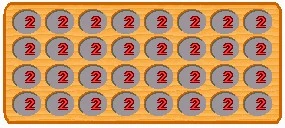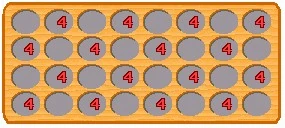| Mangola |
| First Description: Suzanne Comhaire-Sylvain, 1952 |
| Cycles: Two |
| Ranks: Four |
| Sowing: Multiple laps |
| Region: D. R. of the Congo |
Mangola has become in recent decades the most popular mancala game played in the Democratic Republic of the Congo. It is known from the Virunga mountains to the Sudanese border, and from Bangui (Central African Republic) to Arui near Uganda. Mangola is a new game which was developed after 1911 according to the ethnologue Philip Townshend and is now gradually replacing older games such as Sombi and single-lap mancala games. The game was spread by the Belgian colonial administration and military along rivers and roads and is the only mancala game played in the central basin (one of the few African regions where mancala games were still unknown in the 19th century).
Its name could be related to the Arabic Mancala, but could also be just the plural form of "Angola", like the country, a name also used for this game in Kinshasa (observations by V. Bautista i Roca). Furthermore, it is possible that the name has derived from the plural of "N'gola", a title of kings, or that it is related to the town called Mangola in central Equatorial Guinea (Rio Muni).
There are many local variants, probably more than 30, which have slightly different opening rules (some with simultaneous opening moves) and employ different board sizes.
The game is played by adults on beautiful wooden boards with holes carved in the surface. Children, on the other hand, dig the board in the ground or draw it with chalk on concrete.
It is played by both sexes, but more often by women.
The following rules were reported from the capital Kinshasa by Suzanne Comhaire-Sylvain in 1952.
In the 18th and 19th century, European travellers often called Mangala (a mancala game played in Greece and Turkey) "Mangola".
Rules[]
Mangola is a two players game, which is played on a board made of four rows of eight holes.
At the beginning each hole contains two seeds (ngola).
Initial Position
Each player controls the two rows on his side, and only moves in these two rows.
Players take turns to move.
The first move of each player is special. The seeds are redistributed by taking the contents of one hole and then putting them into the next. When each player has moved once, the board is checkered with holes containing four seeds and empty holes.
Position after first move of both players (1/4)
Position after first move of both players (2/4)
Position after first move of both players (3/4)
Position after first move of both players (4/4)
The second move of each player must begin from the left- or right-most hole of his outer or inner row.
On his turn the player picks up all the seeds of one of his holes, which contains at least two seeds and sows them anticlockwise, one by one, into the succeeding holes. Singletons cannot be moved.
If the last seed is dropped in an empty hole, it is moved to the next hole and the turn ends.
If the last seed falls in a non-empty hole, its contents including the last distributed seed are distributed in another lap.
If the last seed falls in a non-empty hole in the inner row, and the two opposite holes of the opponent contain seeds, the player takes the contents of his hole and the contents of both opponent's holes, and then begins with them the next lap after the hole which effected the capture.
If a player can't move (his side of the board is empty or contains only singletons), he has lost the game.
References[]
- Bell, R. C.
- Mangola and Mancala Boards. In: Games & Puzzles 1976; No. 46 (March), 4-5.
- Comhaire-Sylvain, S.
- Jeux Congolais. In: Zaire: Revue Congolaise (Bruxelles) 1952; 6 (4): 351-362.
- Rohrbough, L. (Ed.).
- Count and Capture. Cooperative Recreation Service, Delaware OH (USA) 1955.
- Russ, L.
- The Complete Mancala Games Book: How to Play the World's Oldest Board Games. Marlowe & Company, New York (USA) 2000, 37-41.
- Townshend, P.
- Les Jeux de Mancala au Zaire, au Rwanda et au Burundi. In: Les Cahiers du CEDAF (Bruxelles), Cahier 3, 1977, 32-37.
- Townshend, P.
- Mancala in Eastern and Southern Africa: A Distributional Analysis. In: Azania: Journal of the British Institute in Eastern Africa. 1979; 14: 108-138.
Copyright[]
© Wikimanqala.
By: Víktor Bautista i Roca.
Under the CC by-sa 2.5.




